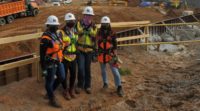With a growing number of projects located in remote areas, workforce development is a key priority for the solar energy construction sector.
One major builder, McCarthy Building Cos., is trying to tackle the challenge by developing programs for apprentices on two large projects in Texas.
On these, apprentice electricians, equipment operators, and other trades are paired with journey-level workers for support in their first year of work. Apprentices are required to complete 144 hours annually of related instruction to improve their sector knowledge and skill sets, says Jared Carlson, McCarthy senior vice president of operations for renewable energy. Upon completion of the apprenticeship, graduates receive a nationally recognized credential from the U.S. Labor Dept., he says.
In addition to learning the skills needed to succeed in solar energy related crafts, apprentices also receive pre-task planning guidance and OSHA safety training and hazard instruction. They also are introduced to construction math, construction drawing and material handling, says Carlson.
Approximately 2,000 construction hires were made in November, a 2.6% increase from the previous year's total for the month,
One McCarthy project is Morrow Lake in Frio County for developer Leeward Renewable Energy, on which the firm is the EPC contractor. The 265-MW project is located on 1,369 acres in and will include more than 565,000 solar modules. Initial site work began in June and construction is set to finish in June 2024. At the peak of construction, the project will have more than 200 workers, including at least 50 electrical, mechanical and equipment operator apprentices.
RWE Clean Energy LLC is developing the other project in Milam County, a 1,606-acre facility with 477,064 modules. McCarthy is responsible for designing, procuring, constructing and commissioning the 260-MW solar facility with battery storage. It broke ground in May and is set for December 2024 completion. McCarthy did not disclose its number of craft workers or apprentices on the project.
Phil Radin, McCarthy senior director for renewable energy, says the firm is implementing prefabrication factory-type operations for mechanical and electrical components on both projects.
“This work is being conducted in a controlled environment and will not only provide efficiencies in the field but also result in higher-quality product installation,” he explains. “Specifically, the mechanical pre-fabrication of the tracker system enhances the control and flow of material for assembly, safer footing for craft workers, increased quality due to consistency thereby delivering an overall better product for the owner.”
Additionally, he says that related to electrical prefabrication, McCarthy prefabricates both the inverter duct bank conduits and electrical combiner boxes. As with the mechanical, prefabrication allows the project to achieve better quality, consistent output, workflow and overall output.
Both projects are also using ground inspection robots to visually inspect critical solar field systems, including back-of-module hotspots and MC4 connector IR inspections.
“The efficiencies of time and resources, freeing up humans for more complicated work, additional safety and quality that robot inspections bring to our solar sites is noteworthy,” Radin says.





Post a comment to this article
Report Abusive Comment